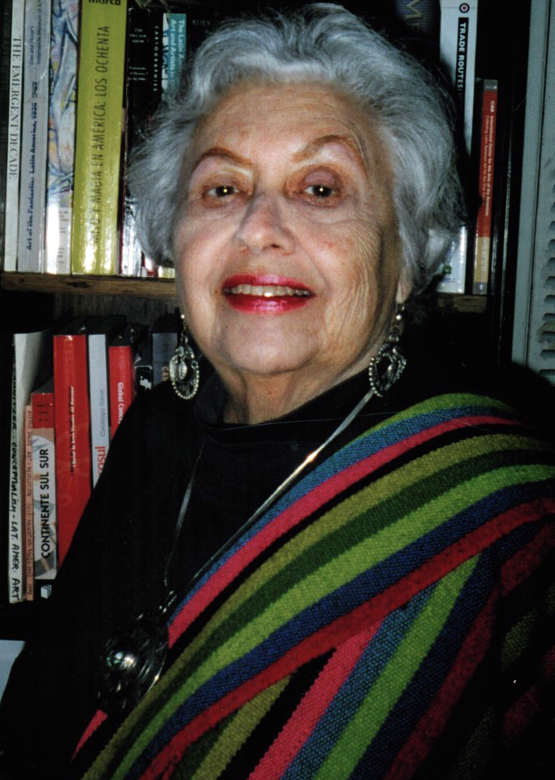Art Historian and Critic, Shifra Goldman Passes Away on 9/11
“I was never in the mainstream, never in all my life. I was born on the margins, lived on the margins, and have always sympathized with the margins. They make a lot more sense to me than the mainstream.”
Shifra M. Goldman, September 1992
By Carol Wells
Shifra Goldman, a pioneer in the study of Latin American and Chicano/a Art, and a social art historian, died in Los Angeles on September 11, 2011, from Alzheimer’s disease. She was 85.
Professor Goldman taught art history in the Los Angeles area for over 20 years. She was a prolific writer and an activist for Chicano and Latino Art. In Dimensions of the Americas: Art and Social Change in Latin America and the United States, one of her award winning publications, she stated that part of her life’s work was to “deflect and correct the stereotypes, distortions, and Euro-centric misunderstandings that have plagued all serious approaches to Latino Art history since the 50s.”
Born and raised in New York by Russian/Polish immigrant parents, art and politics were central to her entire life. Goldman’s mother was a trade unionist and her father, a political activist. She attended the High School of Music and Art in New York, and entered the University of California, Los Angeles (UCLA) as a studio art major when her family moved to Los Angeles in the 1940’s. As an undergraduate, she was active in the student boycott against the barbers in Westwood who refused to cut the hair of the Black Veterans entering UCLA on the GI bill following the Second World War.
After leaving UCLA, she went to work with Bert Corona and the Civil Rights Congress, a national organization working to stop police brutality against African and Mexican Americans, and the deportations of Mexicans and foreign born political activists. Living in East Los Angeles, Gold-man learned Spanish and became immersed in Mexican and Chicano culture. In the 1950’s, during the repression of the Cold War, Goldman was subpoenaed before the House UnAmerican Activities Committee (HUAC). Two decades later, she lost her first college teaching job because a background check revealed that she had been called before HUAC.
In the 1960’s, after supporting herself and her son, Eric, as a bookkeeper for fifteen years, Goldman returned to UCLA to complete her B.A. in art. After receiving her M.A. in art history from California State University, Los Angeles (CSLA), she entered the Ph.D program at UCLA where she ran headlong into Eurocentrism when she was unable to find a chair for her doctoral committee because her topic of choice was modern Mexican art.
Goldman refused to choose a more mainstream topic, and waited several years until a new faculty member finally agreed to work with her. Her dissertation was published as Contemporary Mexican Painting in a Time of Change by University of Texas Press in 1981, and republished in Mexico in 1989. She also initiated and co-authored the bibliography and theoretical essay, Arte Chicano: A Comprehensive Annotated Bibliography of Chicano Art, 1965-1981 (1985) with Dr. Tomás Ybarra-Frausto.
Professor Goldman taught her first class in Mexican Art in 1966, possibly the only one given at that time in all of California. She later went on to a full time teaching position in art history at Santa Ana College where she taught courses in Mexican Pre-Colombian, Modern and Chicano Art for 21 years. She was one of the organizers for the Vietnam Peace Tower in 1966. Goldman also cofounded the Los Angeles chapter of Artists Call Against U.S. Intervention in Central America, in 1983, and was instrumental in bringing solidarity with the Central American struggle to the Los Angeles community.
In 1968, she began the campaign to preserve the 1932 Siqueiros mural America Tropical in Olvera Street, and in 1971 approached Siqueiros for a new mural derived from the original. According to the California Ethnic and Multicultural Archives (CEMA), he agreed but the plan was thwarted by the artist’s death in 1974. His last mural in Los Angeles, Portrait of Mexico Today, 1932, was restored and moved to the Santa Barbara Museum of Art in California with Goldman’s advice and assistance.
Goldman has published and lectured in Europe, Latin America and the United States and led several delegations to Cuba to attend their Art Biennials. In 1994 she became a Research Associate with the Latin American Center at UCLA and taught art history there. Goldman is also Professor Emeritus from Santa Ana College, Santa Ana, CA.
In February 1992, she received the College Art Association’s (CAA) Frank Jewett Mather Award for distinction in art criticism and, in February 1993, an award from the Women’s Caucus for Art for outstanding achievement in the visual arts. She was elected to the board of the CAA, 1995-1999. In 1996 she received the “Historian of the Lions” award from the Center for the Study of Political Graphics.
The Shifra Goldman Papers, including her slides, books, and videos are part of the California Ethnic and Multicultural Archives (CEMA) at the University of California, Santa Barbara. Her extensive Chicano poster and print collection is at the Center for the Study of Political Graphics in Los Angeles. She will be remembered for her important contributions to Latin American Art scholarship and for her seminal work in Chicano/a Art History and support of the Chicano/a art community.
Professor Goldman is survived by her son Eric Garcia, daughter-in-law Trisha Dexter, and grandson Ian of Los Angeles. In lieu of flowers, memorial donations can be made to Avenue 50 Studio [www.avenue50studio.com], Center for the Study of Political Graphics [www.politicalgraphics.org] and/or Tropico de Nopal [www.tropicodenopal.com]. The date and location of an October memorial will be on all of the above websites.


 Arturo Castañares
Arturo Castañares




